-
PERSON TO PERSON (Dustin Guy Defa 2017)
DUSTIN GUY DEFA: PERSON TO PERSON (2017)
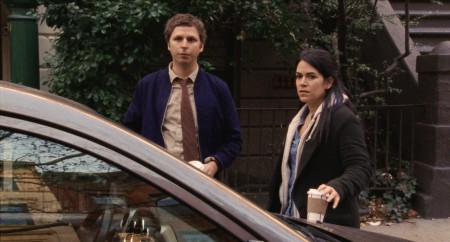
MICHAEL CERA, ABBI JACOBSON IN PERSON TO PERSON
Several short films don't make a long film
This seems like an odd corruption of Mumblecore: the same kind of minor topics and low-keyed acting - but no mumbling. And strangely, we miss that, because Mummblecore's quirky naturalism is lacking, really, and the plots are artificially crisp and neatly resolved, if not particularly interesting. Philip Baker Hall, Abbi Jacobson and Michael Cera add recognizable faces.
The main plots, if you can call them that, are a possible murder covered by two New York Post reporters, or a reporter with a camera (Michael Cera) and an intern (Abbi Jacobson) who he's hoping to date as a result of impressing her; and a vinyl record scam suffered by a guy (Bene Coopersmith) who thinks he's found a rare Charlie Parker disc but discovers it's a reprint with a fake label. A subplot offshoot is Bene's depressed black friend who has fatally alienated his girlfriend by posting nude shots of her on Facebook as revenge for her sleeping with another guy. The possible murder was reported as a suicide by the dead person's wife. She has taken her husband's wrist watch to be repaired. Philip Baker Hall is the watch repairman, who refuses to speak to police or to the journalists.
It must be admitted that Defa has exercised a certain amount of ingenuity in constructing and resolving these stories. But while their separate unreeling alternates through the film, the journalists' story and the vinyl record scam story do not connect, except everything takes place in New York City.
I almost forgot my favorite character, Wendy (Tavi Gevinson), a preternaturally articulate young woman with a prettier, more outgoing best friend. Wendy may be a lesbian, or has simply not tried men, though she starts trying in one scene. Gevinson is the opposite extreme from Mumblcore (though actors in Mumblecore weren't really so inarticulate, very often, as the name implied): she talks like an earnest, punkish version of a Jane Austen character - or someone in Whit Stillman's Metropolitan. If only everyone talked like her, we could dispense with all this running around, which in the case of Bene is carried to an untoward extreme. Bene chases and beats up the man who cheated him, and dresses down the record dealer who said this man was probably okay. This story line, of two young women, the boyfriend of one, and the boy who might like to become Wendy's boyfriend, is reasonable material for a rom-com. Perhaps that could be incorporated with the lovelorn Facebook poster's débâcle.
The murder story probably is beyond the filmmaker's powers to develop on a full scale.
The vinyl record scam is too trivial for anything but a short film. Defa is moving up from shorts to a feature film here, not with total success. Each subplot is handled with adequate detail, but the combination is underwhelming.
Reviewed in Hollywood Reporter by John DeFore in the Next section of Sundance, and at the same screening by Dennis Harvey for Variety. Both acknowledged Defa's evocation of indie films of an earlier time. DeFore seemed to find the effort appealing, its use of Kodak film the equivalent to the story's implied celebration of the "warmer" sound of the older technology of vinyl records. But Harvey found the film not just small scale but "just too damned little," and a "familiar brand of shaggy-comedy-with-pathos that has very little edge." This is true. Defa takes up our time with these details and provides no overriding takeaway. (By the way, Defa has done a lot of acting and is very appealing in that role, as is shown in his performance as the TV producer in Caveh Zahedi's new feature about a TV series, The Show About the Show.)
Person to Person, 84 mins. was screened for this review as part of the 2017 iteration of the FSLC-MoMA series New Directors/New Films, for which it was selected to be the Closing Night Film.
Last edited by Chris Knipp; 03-16-2017 at 07:55 PM.
-
QUEST (Jonathan Olshefski 2017)
JONATHAN OLSHEFSKI: QUEST (2017)
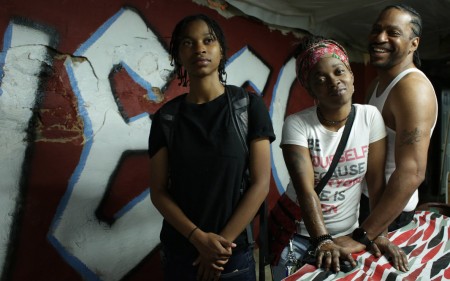
PATRICIA ("PJ"), CHRISTINE'A AND CHRISTOPHER ("QUEST") RAINEY IN QUEST
The saga of a wonderful African American family in North Philly
A multiple-year documentary following a black family, the Raineys, in North Philadelphia who face poverty, hard work, and the violence of the neighborhood with inspiring spirit and courage. The father is the youthful and hip-seeming Christopher Rainey ("Quest"), who works at several jobs delivering papers and circulars to support his family as best he can and keep open his recording studio showcasing local rap artists. The matriarch, also youthful, is Christopher's wife Christine'a, who works at a day job at a homeless shelter and supports the family. She and Christopher look to have a great relationship, and it's gone on for twenty years or more. The filmmaker has described the Rainey family in an interview in Indiewire as "community builders."
The events focus is on their two children. The older son, William, is found to have a cancerous tumor just after a baby boy is born to him. He survives to be a good dad to his beautiful little boy, Isaiah. William's 13-year-old sister is PJ, the Raineys' daughter, a lively, cheerful, independent girl who spends a lot of her time on the basketball court, who is struck by a stray bullet from a far-off gunfight and loses an eye. Thanks to PJ's pluck and the warmth of her parents, she deals with this trauma, and even can still shoot hoops. In time it comes out that PJ is gay. Her parents have trouble dealing with this and "blame" each other or themselves for this happening, as if it was a choice. Olshefski began as a still photographer, not a filmmaker, planning to do a photo series about Quest, the recording studio, and the local rap artists who come there. Then he stayed and became "like a piece of furniture," filming the life of the Rainey family. The family members, and at times the neighborhood, gives themselves to Olshefski's camera and mike, serving as their own articulate narrators.
Much of the action Olsevski shot happens during the time of Barack Obama's presidency and a little more. And the Rainey parents help get people to vote, and posters and portraits in local places remind white viewers what a very special thing it was to have a black president with wife and daughters to match, in the White House, for the past eight years. But Olshefski downplays the timeline and politics: here the issues are local and the support is communal, while the problems are such as urban poor and black America faces all over the country. Price, Christoper and Quest's most promising rapper, develops an alcohol problem that keeps him from achieving his potential. Christopher also contributes to a local radio program, and PJ plays in the Quest house band for a while. It's in the nature of the Raineys that they are creative, interactive, and contributors to the community in multiple ways. Their lives and this documentary film are inspiring. Olshevski hopes that his film will inspire others to follow such communities and give back.
Quest, 105 mins., debuted at Sundance 21 Jan. 2017; will play at Cleveland; was screened for this review as part of New Directors/New Films.
Last edited by Chris Knipp; 03-11-2017 at 10:33 AM.
-
DIAMOND ISLAND (Davy Chou 2016)
DAVY CHOU: DIAMOND ISLAND (2016)
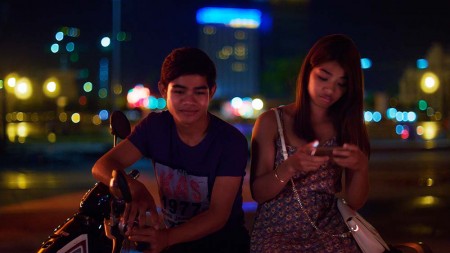
A dreamy slow epic coming-of-age of a country boy in Pnom Penh
Diamond Island is a Cambodian coming-of-age film focused on a young man from the country who comes to a place outside Pnom Penh to work in construction on the titular big new luxury housing development. Buddies, girls, the appearance of his lost older brother figure. A very visual film, full of night lights, fluorescent neon-pastel colors, and pretty faces: considerable formal beauty, a hypnotic mood. Though it can feel a bit static at times, almost like Kabuki theater, this film features what is at once a very distinctive and personal style and moments that may bring to mind Apichatpong Weerasethakul and Jia Zhang-ke. Davy Chou, the filmmaker, is Cambodian-French, and the production has heavy French involvement.
The protagonist is Bora (Sobon Nuon), a handsome young guy from the provinces who says goodbye to his sick mother and comes to work on a new overblown resort center called Diamond Island. He falls in with three other guys including the punkish Dy (Mean Korn). Near the site are some girls, including the perfectly pretty Aza (Madez Chhem), who takes an interest in him, though he holds back at first.
Sometimes conversations are hieratic and formal, with two characters standing at some distance and addressing each other slowly, underlining the film's intentionally deliberate pace and sometimes dreamlike feel (and there are dreams, too), perhaps also to show their subservience to the encroaching urban landscape. This use of space is the case when Bora's older brother Solei (Cheanick Nov) mysteriously appears, standing in the semi-darkness. They have not met for five years and Solei is out of touch with their family. Solei has long hair tied back and is dressed in black and is taller and has a nice motorcycle, money, and his own older posse of cooler, more distant guys and their girls and bikes. His wealth is due to his American "sponsor," presumably gay lover, though this is never explained, presumably not understood by the provincial, naive Bora. Boys and girls barely even kiss, and much of the action takes place outdoors, and at night, in glowing, romantic light. Beautiful glowing urban landscapes show partly unfinished buildings.
This film is all about the images and the dreamlike, hypnotic movement of the leisurely action. One of the key events is a non-event: the news that Solei's "sponsor" will not be taking them to America, and that Solei will not keep his promise of seeing their mother again. It is all sad and frustrating except that feelings are muted too, sorrow of loss reduced to a funeral seen from a distance. A slight flash-forward shows Bora doing well working in a non-labor job and looking "cool," as one of his work site pals, now a security guard, insists.
The mincing sound of Cambodian and Thai speech and the delicacy of the young men makes one expect the handsome Bora, on whose face the camera is wont to dwell, to be part of a gay coming-of-age story, a possibility that Solei's "sponsor" hints of too. But this is averted, if it was ever there. No, Bora is ostensibly straight, but sexuality is refined and neutralized in this aestheticized world.
Jordan Minzer's Hollywood Reporter reivew sees links with Satyajit Ray’s Aparajito (for the country-to-city plot) and Tsai Ming-liang's Rebels of the Neon God, the latter obviously faster paced and more intimate in feel. He connects images of the motorcycle riders in Rebels with some beautiful shots of boys on their bikes at night seen from above here. Solei's bike has blue lights on it that glow. Minzer notes that DP Thomas Favel (Gaz de France), whose importance to Chou might be compared to that of Christopher Doyle to early Wong Kar-wai, helps the filmmaker develop "a rich palette of blues and yellows,contrasting the dusty [yellow] world of condo construction with the candy-colored [blue and pink] nightclubs and amusement parks that Bora frequents as he emerges into adulthood."
Catherine Bray in her Variety review naturally talks about the visuals too, noting the color grading pushes some scenes, particularly of a fairground, to "wildly saturated fluorescence." She also notes an original stylized aspect to the sound, so that in a nightclub "noise and music" are "mixed low and the dialogue delivered in a whisper, a counterintuitive effect given the typical club-scene reality of having to shout at people only a few inches away."
Not everything is successful, and the non-professional actors sometimes seem clumsy. But Chou sets a certain standard for stylishness in such a films. This is film as aesthetic ritual. Even as the young men and construction site action has a vérité naturalism, it is often stilled to beautiful static tableaux.
Diamond Island, 101 mins., debuted at Cannes Critics Week. It opened in French cinemas 28 Dec. 2016 and received enthusiastic reviews (AlloCiné press rating 3.8/5 based on 24 reviews). Screened for this review as part of the 2017 FSLC-MoMA New Directors/New Films series.
Last edited by Chris Knipp; 03-09-2017 at 09:37 PM.
-
THE LAST OF US/AKHER WAHED FINA (Ala Eddine Slim (2016)
ALA EDDINE SLIM: THE LAST OF US/AHKER WAHED FINA (2016)
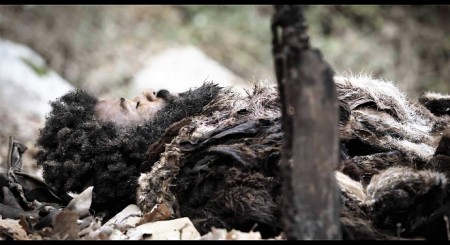
JAWHAR SOUDANI IN THE LAST OF US
A conceptual Robinson Crusoe film that plays with the hot issue of immigration
This is a Tunisian film shot in Tunisia. It's spoken of as an immigration film. The film's own website says, "N is a young sub-Saharan man who crosses the desert in order to reach North Africa and be smuggled into Europe." But this is, as it progresses, more and more a myth with surreal, primal elements. The film website states that N "meets an altered image of himself." A lot of this film's early section feels like something Claire Denis might do - till it turns into a apocalyptic kind of Robinson Crusoe story in which the Robinson follows an ancient gnarly Friday around and takes on his role of old stancher and lone survivor - the meaning presumably of the title, The Last of Us. Props to Jawhar Soudani, who plays N, who carries the film as its protagonist, providing a sympathetic and strong presence even though he never utters a word. The Last of Us is a haunting and beautifully photographed film whose acting is impeccable and tech credits are excellent. There are several haunting landscape images worthy of Carlos Reygadas' Post Tenebras Lux.
This is a case where the festival blurb is pretty nearly perfectly accurate. Indeed two men silently traverse a vast, flat landscape. Nobody speaks, from beginning to end of the film. The two men get in the back of aa smuggler's truck, and soon after are caught in a holdup by men with guns. Only one of the men appears to escape from this melee, and we follow him for the saga that follows. He hides out near the sea for a long time, surviving on scraps, and then steals an outboard motor and attaches it to a rough derelict old boat. He sets out across the sea, but where he lands we do not know.
When lost in the heavily forested landscape, N falls into a trap and is severely wounded in one leg. He suffers the torture of the damned and it looks as thought this is the end. But a rope is thrown to him, and when he is passed out, his wound is treated with natural remedies. When he awakes he sees the large, ancient M (Fathi Akkari), a wild hermit draped in many layers of animal skins. As N heals, he follows M and depends on him. They live largely on small animals they cook. N starts to put on skins like M and his hair and beard grow out and he begins to resemble his dominant Man Friday.
The Last of Us is a beautifully made feature debut that resembles what might be a student short film in its material. It is worthy of close festival attention but would seem to have limited theatrical release potential. Ala Eddine Slim has a background in documentaries and shorts.
The Last of Us/آخر واحد فينا (Akher Wahed Fina), 95 mins., debuted Sept. 2016 at Venice International Critics Week, where it won the Luigi De Laurentiis Award for Best Debut Film. The Paris-based Still Moving acquired world sales rights to the film at Venice. Also shown at Rotterdam, Lyon, and New Directors/New Films (Mar. 201); it was screened as part of the latter for this review.
Here is the trailer.
Last edited by Chris Knipp; 03-10-2017 at 06:23 PM.
-
THE WOUND/INXEBA (John Trengove 2017)
JOHN TRENGOVE: THE WOUND/INXEBA (2017)
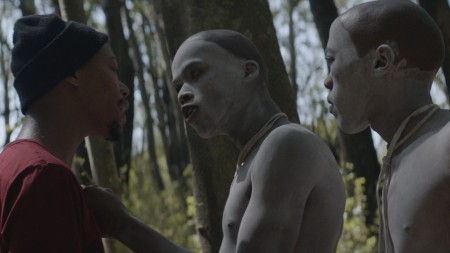
NAKHANE TOURÉ, NIZa JAY NCOYINI (FROM LEFT) IN THE WOUND
A striking if unbalanced directorial debut tackles powerful material
This movie has powerful material and a strong authentic feel to its setting of a Xhosa manhood ritual for adolescent boys taking place in a mountainous corner of the Eastern Cape of South Africa. However, director John Trengove goes astray in various ways. The theme of the two older "caregivers" who are secretly gay is not revealed gradually as it ought to be, but in our face early on, and the theme is hit over and over repetitiously. Meanwhile the Xhosa ritual is inadequately presented, when it ought to provide the strong solid underpinning for the story. However, Trengove is a promising director from South Africa with an MFA in filmmaking from NYU who already has ten years of experience in Theater and TV, and his shooting method in this feature debut is intense and engaging, if (perhaps willfully) chaotic.
The main characters are three: first the "rich" boy from the city of Johannesburg, Kwanda (Niza Jay Ncoyini); the sensitive factory worker Xolani (musician Nakhane Touré); and the more macho, married Vija (Bongile Mantsai), whom Xolani seems to be in love with. The other initiate boys barely emerge as individuals, or do the various elders and villagers. Kwanda's uncle sends him off to this event, thinking he's too soft. He may be, but he's also contemptuous of the whole thing.
And when Xolani is put in charge of Kwanda as his "caregiver," Kwanda soon guesses he is gay and senses his relationship to Vija and even warns him Vija will never really care about him. It's not clear how Kwanda knows all this. Perhaps his sexuality is similar and it's "gaydar"? However, the other young initiates' feelings toward Kwanda are differently motivated. They resent him for being a city boy and a rich boy.
The most interesting thing is that Kwanda isn't as macho perhaps as the other youths, yet is bold in setting himself apart from them. But his unwillingness to fully play along with the rituals is a risky move in this environment that will have dire consequences.
[I]The Wound/Inxeba[/I, 88 mins., debuted at Sundance Jan. 2017, and will be theatrically released in France 15 Apr. 2017. It was screened as part of the 2017 FSLC-MoMA New Directors/New Films series. To be a Kino Lorber release in the US. Releasing in France 19 Apr. 2017 as Les Initiés.
Last edited by Chris Knipp; 04-04-2017 at 01:07 PM.
-
ALBUM (Mehmet Can Mertoğlu 2016)
MEHMET CAN MERTLGLU: ALBÜM (2016)
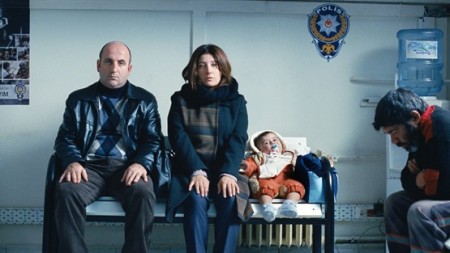
Pointlessly elaborate subterfuges
What's clear is that this Turkish film owes something to the unpleasant bureaucracy and unpleasant people of the modern Rumanian cinema, and director-writer Mehmet Can Mertoğlu has even engaged Marius Panduru, the dp for Cornelieu Porumboliu's Police, Adjective’s to shoot the deeply drab 35mm. images. But while Mertoğlu has an unusual and strange subject, he has lost a sensible focus right from the first - a prelude about a cow giving birth and in vitro fertilization. It would have been better to get to the couple right away and stick to a clearcut tone. Is this social satire or something more surreal? Are we supposed to hate this couple or feel sorry or laugh?
When we meet Bahar (Şebnem Bozoklu), an employee in the government tax office and her husband, Cüneyt (Murat Kilic), a high school history teacher, everyone else in her offices is asleep with their head on the desk, and Cüneyt sits at his desk while his history class is preposterously disorderly, an obviously fake staging. This is bizarre. But what does it mean?
It is also clear that this couple can't have a baby, and this is shameful in Turkish culture, so they are carefully faking it. Bahar is wearing a fake pregnant stomach, and Cüneyt is constantly shooting her at the beach, at home, at a doctor's, later at a hospital, to assemble a "pregnancy album."
They won't take the first child offered, a girl they think is too dark, Syrian, Kurdish, and boyish looking. They move from the city of Antalya to distant Kayseri where later they get a boy, as they wanted. But they seem to find him merely an annoyance. He doesn't seem to sleep, but there's nothing wrong with him.
A relative, the orphanage director, every bureaucratic person they meet, is indifferent to his job, foul-mouthed, unfocused - more interested in football and mean to subordinates. The second orphanage director is still playing an online card game when the couple is already in his office. Is this meant to be funny? Or is it, again, a critique of Turkish society today?
Finally the couple is brought more brusquely into contact with authorities when a burglar (in their 11th floor apartment!) escapes by jumping out the window. Cüneyt, who by the way has a strictly well-behaved class now, as far in the other extreme, at his new Kayseri assignment, is forced to spend overnight at the police station because he's the last person who saw the burglar. From this foulmouthed and rude police chief he learns that they have all the couple's facts, including that they recently adopted a baby. They now know their relatives will find out. Nonetheless they start thinking of another reassignment, but obviously two in one year isn't possible, and the option that comes up is Chad - or Djibouti, but Cüneyt has heard things aren't too stable there.
There is a funny movie buried here - of a couple obsessed by appearances and incapable of becoming appropriate parents. A mainstream comedy would have them won over by the cute baby. In a darker comedy they'd just remain bad parents. But Mertoğlu is distracted by too much material that hopelessly muddles things. This film debuted at Critics Week at Cannes and won multiple nominations and some awards at various festivals, but it hasn't any chance of appealing to theatrical audiences.
Albüm, 105 mins., amazingly has shown at over thirty festivals, though mostly relatively obscure ones, after Cannes (where Boyd van Hoeij in Hollywood Reporter was no more pleased than I was by this mysterious and scattershot effort). I think this is one of these cases when a film gets passed from one festival to another without anyone looking beyond the enthusiastic festival blurb. I notice that the ND/NF one has confused the husband and wife's occupations: whoever wrote it doubtless had not seen the film. Screened for this review as part of the Mar. 2017 New Directors/New Films series.
Last edited by Chris Knipp; 04-15-2017 at 10:39 PM.
 Posting Permissions
Posting Permissions
- You may not post new threads
- You may not post replies
- You may not post attachments
- You may not edit your posts
-
Forum Rules





 Reply With Quote
Reply With Quote





Bookmarks